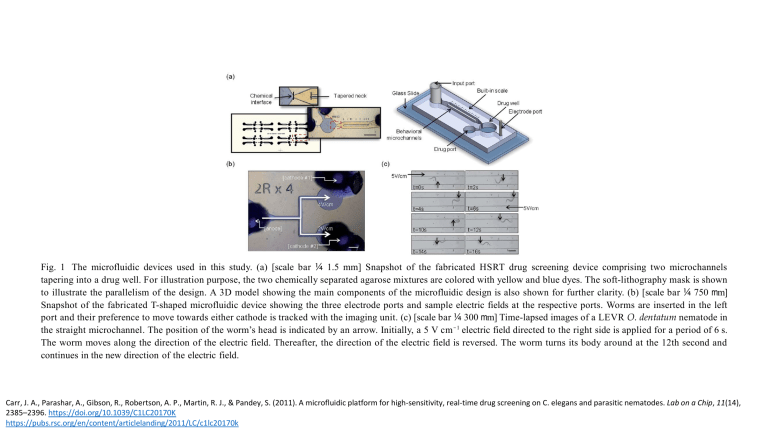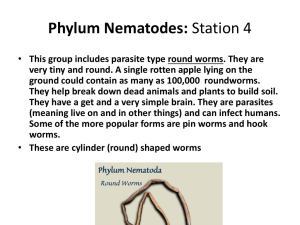
Fig. 1 The microfluidic devices used in this study. (a) [scale bar ¼ 1.5 mm] Snapshot of the fabricated HSRT drug screening device comprising two microchannels
tapering into a drug well. For illustration purpose, the two chemically separated agarose mixtures are colored with yellow and blue dyes. The soft-lithography mask is shown
to illustrate the parallelism of the design. A 3D model showing the main components of the microfluidic design is also shown for further clarity. (b) [scale bar ¼ 750 mm]
Snapshot of the fabricated T-shaped microfluidic device showing the three electrode ports and sample electric fields at the respective ports. Worms are inserted in the left
port and their preference to move towards either cathode is tracked with the imaging unit. (c) [scale bar ¼ 300 mm] Time-lapsed images of a LEVR O. dentatum nematode in
the straight microchannel. The position of the worm’s head is indicated by an arrow. Initially, a 5 V cm -1 electric field directed to the right side is applied for a period of 6 s.
The worm moves along the direction of the electric field. Thereafter, the direction of the electric field is reversed. The worm turns its body around at the 12th second and
continues in the new direction of the electric field.
Carr, J. A., Parashar, A., Gibson, R., Robertson, A. P., Martin, R. J., & Pandey, S. (2011). A microfluidic platform for high-sensitivity, real-time drug screening on C. elegans and parasitic nematodes. Lab on a Chip, 11(14),
2385–2396. https://doi.org/10.1039/C1LC20170K
https://pubs.rsc.org/en/content/articlelanding/2011/LC/c1lc20170k
Fig. 2 Electrotaxis preference and sensitivity results for O. dentatum nematodes (a) The preference data for SENS and LEVR nematodes between four pairs of electric
fields is shown (i–iv). The percentage of the total O. dentatum nematodes attracted by each electric field is plotted. (b) The sensitivity data for SENS and LEVR nematodes
in the absence and presence of 3 mM levamisole. The percentage of worms responding to the applied electric field is plotted. In the absence of levamisole (i), few worms
(< 10%) are responsive below electric fields of 2 V cm -1 while most worms (83% LEVR, 83% SENS) respond to electric fields above 4 V cm -1. Exposure to 3 mM
levamisole does not significantly alter the worms’ responsiveness to the electric field (ii).
Carr, J. A., Parashar, A., Gibson, R., Robertson, A. P., Martin, R. J., & Pandey, S. (2011). A microfluidic platform for high-sensitivity, real-time drug screening on C. elegans and parasitic nematodes. Lab on a Chip, 11(14),
2385–2396. https://doi.org/10.1039/C1LC20170K
https://pubs.rsc.org/en/content/articlelanding/2011/LC/c1lc20170k
Fig. 3 Effects of decreasing channel resistance and characterization of nematode velocity in an electric field. (a) [scale bar ¼ 300 mm] Time- lapsed images of a LEVR O. dentatum nematode in
the straight micro- channel are shown for a low (~0.3 mA) (i) and high (~2.5 mA) (ii) current in the channel. The electric field is turned on at time t ¼ 0 and the reaction of the worm is videographed.
In the case of low current, the worm initially retracts, turns its head around to align with the field direction and begins to move in the direction of the electric field. In the case of high current, the
worm initially retracts, but quickly curls and becomes unresponsive. (b) The effect of changing the net resistance of the microchannel on the O. dentatum nematodes. As the resistance
is decreased, the current flowing in the microchannel increases. At currents above 1 mA, more worms are hindered by the current and become unresponsive – thus control of worm movement is
lost.
Carr, J. A., Parashar, A., Gibson, R., Robertson, A. P., Martin, R. J., & Pandey, S. (2011). A microfluidic platform for high-sensitivity, real-time drug screening on C. elegans and parasitic nematodes. Lab on a Chip, 11(14),
2385–2396. https://doi.org/10.1039/C1LC20170K
https://pubs.rsc.org/en/content/articlelanding/2011/LC/c1lc20170k
Fig. 4 The measured velocity of the worms’ centroid position is plotted at different electric fields. The average velocity is
unaffected by the applied electric field and confirms that the electric field only influences the direction of movement. These
results are in correlation with previously published results on C. elegans.47
Carr, J. A., Parashar, A., Gibson, R., Robertson, A. P., Martin, R. J., & Pandey, S. (2011). A microfluidic platform for high-sensitivity, real-time drug screening on C. elegans and parasitic nematodes. Lab on a Chip, 11(14),
2385–2396. https://doi.org/10.1039/C1LC20170K
https://pubs.rsc.org/en/content/articlelanding/2011/LC/c1lc20170k
Fig. 5 (a) Dose response generated by parameter (i), percentage of worms responsive, for O. dentatum (SENS and LEVR) (i) and C. elegans (L4 stage N2 and lev-8) (ii)
nematodes in the microfluidic drug screening device. At low levamisole concentrations (0.1 mM for SENS, 10 mM for LEVR, 1 mM for N2 and 3 mM for lev-8), almost all
worms are responsive. At higher concentrations, the percentage of worms unresponsive increases and eventually, at the cutoff concentration (~100 mM for SENS, ~150 mM
for LEVR, ~100 mM for N2 and ~250 mM for lev-8), all worms are unresponsive. (b) [scale bar
¼ 0.5mm] Representative tracks of L4 stage N2 C. elegans in the drug well of the microfluidic drug screening device. The tracks, shown as a function of time, give
quantification as to how movement changes when the worm exposed to high (100 mm) dose of the drug. Initially, worm movement is spread over a large surface area; as time
progresses, the amount of surface area reduces and eventually the worm becomes unresponsive.
Carr, J. A., Parashar, A., Gibson, R., Robertson, A. P., Martin, R. J., & Pandey, S. (2011). A microfluidic platform for high-sensitivity, real-time drug screening on C. elegans and parasitic nematodes. Lab on a Chip, 11(14),
2385–2396. https://doi.org/10.1039/C1LC20170K
https://pubs.rsc.org/en/content/articlelanding/2011/LC/c1lc20170k
Fig. 6 (a) Dose response parameter (ii), percentage of worms leaving the drug well to the total worms entered, is plotted for C. elegans (i) and O. dentatum (ii). Below a
certain concentration (0.1 mM for SENS, 1.0 mM for LEVR, 0.1 mM for N2 and 0.1 mM for lev-8), most of the worms (>90%) entering the drug well are able to exit after
exposure. Above this concen- tration, the percentage of worms that manage to exit the drug well decreases steadily. Above a cutoff concentration (100 mM for SENS, 150 mM
for LEVR, 30 mM for N2 and 150 mM for lev-8), all worms are unable to exit the drug well. (b) Dose response parameter (iii), average velocity, is plotted for C. elegans (i)
and O. dentatum (ii). At concentrations higher than 0.1 mM, the SENS velocity decreases sharply while the LEVR velocity exhibits a sharp decrease above 1.0 mM (a-i). For C.
elegans, the N2 forward velocity decreases sharply at concentrations higher than 1.0 mM, while the lev-8 velocity shows a similar decrease above 3 mM (a-ii).
Carr, J. A., Parashar, A., Gibson, R., Robertson, A. P., Martin, R. J., & Pandey, S. (2011). A microfluidic platform for high-sensitivity, real-time drug screening on C. elegans and parasitic nematodes. Lab on a Chip, 11(14),
2385–2396. https://doi.org/10.1039/C1LC20170K
https://pubs.rsc.org/en/content/articlelanding/2011/LC/c1lc20170k
Fig. 7 Time response of the drug effect on the nematodes in the drug well. (a) Box plot of the total time from initial exposure of 100 mM levamisole to unresponsiveness for O.
dentatum and L4 stage C. elegans. Median times for restraint strains (LEVR median ¼ 8.5 min; lev-8 median ¼ 3.750 min) were found to be significantly higher than the
median times of their sensitive counterparts (SENS median ¼ 3.7 min; N2 median ¼ 0.4 min). (b) [scale bar ¼
~200mm] Time-lapsed images of SENS O. dentatum being exposed to 100 mM levamisole in the drug well. The drug effect is tracked on a particular
nematode (indicated with an arrow). The worm is able to move freely in the initial 120 s, after which time the drug begins to render the worm unre- sponsive within the
next 120 s.
Carr, J. A., Parashar, A., Gibson, R., Robertson, A. P., Martin, R. J., & Pandey, S. (2011). A microfluidic platform for high-sensitivity, real-time drug screening on C. elegans and parasitic nematodes. Lab on a Chip, 11(14),
2385–2396. https://doi.org/10.1039/C1LC20170K
https://pubs.rsc.org/en/content/articlelanding/2011/LC/c1lc20170k



